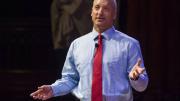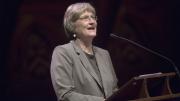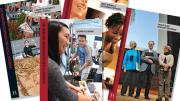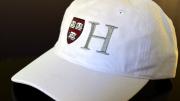Speaking on the morning of October 26, Dean Michael D. Smith introduced the Faculty of Arts and Sciences’ (FAS) $2.5-billion capital campaign—the largest component of the $6.5-billion Harvard Campaign (unveiled on September 21) and a sum nearly equal to the last University-wide campaign, which concluded in 1999. Just over $1 billion—40 percent of FAS’s goal—has been pledged or received. (The University's tally has reached $3 billion, up from the $2.8 billion announced at the September launch.) Counting the separate, unspecified sum—likely hundreds of millions of dollars—included in the University’s campaign objectives to pay for construction of the Allston science complex, where a significant part of the expanding School of Engineering and Applied Sciences (SEAS, a school within FAS) will be rehoused, nearly half of Harvard’s fundraising for this capital campaign focuses on FAS objectives.
The launch events coincided with the regular fall gathering of the Harvard Alumni Association and Harvard College Fund, usually held on the Harvard Business School campus. (Unintended irony department: the alumni association's luncheon guest, Bass professor of government Michael J. Sandel, internationally known for his "Justice" course on moral reasoning, spoke on "What Money Can't Buy," the title of his recent book.) Given the FAS focus of this year’s meeting, however, the venue was, fittingly, changed to Cambridge, at the intersection of twenty-first-century Harvard (the renovated Science Center plaza, where guests dined privately Friday night, and convened for breakfast and lunch Saturday) and nineteenth (Sanders Theatre, where the speeches were made). En route from breakfast, under the tent on the plaza, to Sanders, guests passed a very twenty-first-century protest: students held signs and distributed leaflets advocating University sale of investments in fossil-fuel producers—an action President Drew Faust recently announced Harvard would not pursue—and diversion of campaign contributions to the Divest Harvard Escrow Fund ("You don't have to donate to climate disaster").
In Sanders, guests saw a video of students, professors, University fundraising officers, and leaders—Smith, Faust, Provost Alan Garber—holding white cards on which they had written their response to the prompt, "At Harvard, I Discovered…": a major theme of the FAS campaign, in the sense of personal discovery through education and discoveries that benefit humanity. Smith's message, showing him in the Faculty Room in University Hall, read, "History. Let's make some together!"
"We Need Both"
Campaign co-chair Glenn H. Hutchins '77, J.D.-M.B.A. '83, a private-equity investor, began the morning's formal exercises by recalling his first experience of Sanders Theatre as a freshman in September 1973. He explained the statues flanking the stage: James Otis, A.B. 1743, a leading figure in early American Revolutionary politics, and Josiah Quincy, Harvard's president from 1829 to 1845, who, Hutchins said, modernized and professionalized the still-fledgling university. To these two figures—one the rebellious alumnus, the other a reforming leader—Hutchins added a third name: Charles Sanders, A.B. 1802, whose philanthropic largess ($40,000 went a lot farther then) had yielded the eponymous meeting hall, "the place where the Harvard community gathers to make history."
The history about to be made was obviously philanthropic as well. Of the current campaign, Hutchins said, "Harvard has always operated at a scale imaginable only to us and unattainable by anyone else." Could those assembled meet this challenge? Hutchins asked. Invoking the Harvard Law School graduate who is now president of the United States (whom Hutchins has supported, and with whom he was reported to have played golf on Martha's Vineyard last summer), he thundered, "Yes we can!" And then he introduced President Faust. Referring to her discipline, Faust noted, with amusement, that the campaign had already had the remarkable effect of turning Hutchins into an historian, too.
In her remarks, Faust invoked a student voice to articulate the University's aspirations, for those who study and those who conduct research at Harvard:
At this year’s Freshman Convocation, a senior named Erin Drake spoke compellingly about letting go of a laundry list of things she wanted to do at Harvard in order to explore who she wanted to be afterwards. “What kind of person,” she asked the members of the incoming class, “do you want to be? What contributions do you want to make in your communities? And what are you going to do with the privilege of going to Harvard College?”
Erin’s questions point to something at the heart of a liberal arts education. It is not simply about what you want to do. It is about who you want to be. It is about striking out and testing your limits, exploring your passions, engaging your curiosity to the fullest, trying your best—maybe trying even better than what you thought was your best. It is about the opportunity to ask where human civilization has been, where it might go, and how an individual of talent and imagination can play a meaningful part in taking it there.
We create zones of patience and contemplation across the University, slowing the frantic pace to make time for imagining the new and uncovering the old, for remembering and revisiting and reconsidering. Here, we raise fundamental questions and develop innovative solutions, driving discovery as we improve the world. We need both.
She spoke warmly of Dean Smith as a colleague and friend, describing him as the perfect leader "to kick off a campaign that will advance the arts and sciences at Harvard, raising our sights ever higher to advance understanding and to serve mankind."
Campaign co-chair Carl J. Martignetti ’81, M.B.A. ’85, president of a wine and spirits distributorship, then did the heavy lifting, describing FAS and the University today: he called it "an amazing time at Harvard" in terms of educational innovation, intellectual collaboration, and admissions, among other metrics—strengths he attributed to Faust and Smith. Suggesting that they were too modest to accept accolades for these accomplishments, he asked, "Will you at least agree you didn't prevent them from happening?"
He then outlined FAS's role in the Harvard Campaign, as the part of the University unique in size, history, and the emotional connection it asserts ("Harvard Yard is still my favorite place on earth")—and therefore the largest component of the campaign overall, with a $2.5-billion goal, two-and-one-half times larger than the next individual school goal (as yet unannounced). He thanked various leaders of the campaign, including SEAS co-chairs Paul A. Maeder, M.B.A. ’84, and Herbert S. Winokur Jr. ’65, Ph.D. ’67, respectively a venture capitalist and a private investor. And then he revealed that FAS had crossed the $1-billion threshold in gifts and pledges just in time for the day's launch announcement. Of the goal, he said, the leaders were committed "to exceeding it."
After Chase Morrin '15, a neurobiology concentrator from Quincy House, performed a lively jazz piano riff on "Ten Thousand Men of Harvard," campaign co-chair Sandra Matejic Edgerley ’84, M.B.A. ’89, told the audience, "So much of what was great when I was an undergraduate is still in place," from the core campus to the conversations that take place in Harvard Yard or the Stadium, to courses like expository writing and Economics 10. Now, from the experience of two sons who are enrolled in the College, she said, she had learned that "So much is also really different," from the Science Center plaza to reimagined classrooms and online learning. She then introduced Dean Smith, citing him as a leader who "embodies that tradition—the preservation of what makes Harvard so exceptional…and yet Mike is incredibly innovative. He's a forward thinker."
“Magic Happens”
As dean, Smith—a computer-science professor from SEAS—has perhaps been best known by colleagues for financial engineering: reworking operations in the wake of the 2008 financial crisis and subsequent sharp erosion in the value of the endowment (FAS’s largest revenue source by far) to eliminate deficits and establish a new base for academic growth. So he must have taken special pleasure in devoting his campaign address to a different priority: the potential for enhanced teaching and enriched learning. He must also have enjoyed springing a surprise. Appearing on stage in a blazer and khakis, he shed his jacket and draped it over a stool. Then, instead of retreating to the lectern, Smith—who acknowledges that he is not a natural public speaker—began walking the stage, and delivered his entire 2,000-word address without a paper text.
Referring to Sanders itself, he said:
Its organizing principle is simple: teacher and students; stage and seats.
A simple setup, but magic happens here every day. The catalysts are equally simple and enduring. Just combine someone’s desire to learn with another’s passion for teaching.
This beautiful lecture hall was built in the 1870s, and yet the intervening 140 years haven’t diminished the power of what happens here. The world, on the other hand, has changed tremendously over those years.
Smith has regularly championed learning and teaching initiatives: he is a member of the HarvardX leadership committee and a board member for edX (the Harvard-MIT online learning partnership); has appointed a HarvardX leader as the new faculty director of FAS’s Bok Center, aiming to revitalize it as a locus for investigating learning and applying the findings to the classroom; and has recruited a new Extension School dean steeped in contemporary learning technologies. Still, it was revealing of his vision for FAS to see him devote his campaign address to learning and teaching, describing an arc from his own toy blackboard as a youth, through overhead projectors and other technologies seen as revolutionary in their day (props appeared on stage as he talked). Even as he made the case for that kind of innovation, Smith brought education back to the in-person engagement of teacher and student in a classroom setting. “This is a moment of disruption in the landscape of higher education,” he said. “This is a moment that offers Harvard, through this campaign, the opportunity to shape the future and lead in learning”—not just as individual professors adapt their teaching, but across the institution. “Leading in learning” is one of six priorities for FAS’s campaign (see below).
With that, speaking to real people—FAS’s core supporters, campaign volunteers, and staff—in a real place, Smith concluded on a note of reassurance, anchoring online-learning objectives to the hallowed, familiar ground of the campus:
So why are we here? In this place? All together at the same time?
Why didn’t I send this speech to you in an e-mail? Or in a video on Facebook that each of you could review at your leisure?
Our campaign makes the bet that place still matters. Especially this unique place. We believe in the power of the chance meetings that occur every day across this campus. We believe in the power of direct engagement.
People impact each other in truly profound ways—that is a truth across time. Think about your experience at Harvard and the people who touched your life, and changed your thinking.
Now think about a classroom that gets a student out from behind a notebook and into conversation with their professor and peers. Role-playing as a decision-maker in a moment in history. Debating how the pyramids rose from the sand. Or understanding the physics of a perfect fade-away jump shot.
Swoosh. Magic.
That’s when your mind is opened up to the world around you, to the thrill of a new discovery, to the satisfaction of really understanding an old truth.
That’s when you discover the power of collaboration, intellectual partnership, and principled choices.
That’s when you discover what matters, what makes a life well-lived, how you can make a difference in the world.
Arts and Sciences’ Aims
During a pre-launch conversation in his University Hall office, Smith sorted FAS’s six goals into two groups of priorities: “What do we care about most?” (those core commitments that “strengthen the current, ongoing activities…critical to our mission of research and teaching here”) and where “we need to invest” (“new things that the future requires us to look at”).
Among the former, he emphasized:
Undergraduate financial aid ($600 million). The past decade’s increases in aid, and the College’s commitment to sustain them as family need rose during the recession (and FAS’s long-term assets fell by $5 billion), “have had nothing but upside,” he said, referring to the student beneficiaries. But he worries about sustaining that situation “at the scale we have today,” and so nearly a quarter of FAS’s campaign goal will focus on securing this core value, lest a future dean confront a crisis in assuring access to the College.
House renewal and the student experience ($500 million, of which $400 million is for House renewal). “Our commitment to residential education is as strong as it has ever been,” Smith said; one-fifth of the campaign goal is focused on students’ “learning across our campus,” not just in classrooms. Most of those funds are for the multiyear, $1-billion-plus House renovation and updating now under way (see Harvard Magazine’s November-December feature, “Learning, and Life, in the Houses”). According to its fiscal 2013 report, FAS had spent $51 million on House renewal (planning, construction, and student swing space) through last June 30—$45 million for the renovation of Old Quincy into Stone Hall, home to 180 undergraduates; the full project will require use of endowment funds, reserves, debt financing, other cash—and philanthropy. (In fact, as detailed in the financial sections to Smith’s 2012 and 2013 annual reports, FAS has made significant “decapitalizations”—distributions of appreciation—from its endowment to help fund the early stages of House renewal planning and construction, and prepaid debt to make room for future, fresh borrowing later in the project.) But as he emphasized during the conversation, “This…is going to be successful because of the support of our alumni”—who had already pledged $140 million toward the work. Corrected March 31, 2014, based on revised information provided by the Faculty of Arts and Sciences: the sum pledged as of the end of fiscal year 2013 was $104 million.
Faculty and the scholarly enterprise ($600 million). Another 20 percent of the campaign will be dedicated to this category, in three ways. First, in securing endowed chairs (two-thirds of FAS’s tenured positions are endowed today) because professors are “worthy” of a career step beyond achieving tenure. (There will also be “a little bit” of faculty growth as well, Smith said.) Second, in supporting graduate-student fellowships—all the more pressing as cuts in federal-research funding restrict the prevailing support for science graduate students. Third, in underwriting new research and supporting the work of junior-faculty members and newly tenured professors. For example, he cited the Institute for Quantitative Social Science, which has pioneered techniques enabling many faculty members to work with large data sets and pursue new inquiries. (The institute’s director, Weatherhead University Professor Gary King, moderated the “big data” symposium—see a full report on the symposiums; read an early account of the research, and a recent study on Chinese censorship of social media.) According to the case statment, some $350 million is sought for professorships, $50 million for faculty research fellowships, $80 million for graduate fellowships, $15 million for arts lectureships, and $105 million for academic programs and the library system.
The forward-looking emphases in FAS’s campaign plan—the areas Smith described as critical investments—include:
Leading in learning—the theme highlighted in his Sanders address ($150 million). Basic understanding of cognition has advanced, Smith suggested, and effective technology has finally come to the classroom. He strongly supported professors’ experiments with the HarvardX platform, “flipped” formats (students view lectures before class, and then work together and with faculty on problems in class), and hands-on design in engineering courses, on a campus long focused on lectures. Other funding will underwrite course development, reconfigured classrooms, and training across FAS, so “Harvard can show true leadership in higher education.” The case statement emphasizes funding for the Bok Center; SEAS's "learning incubator," and HarvardX.
SEAS ($450 million, including some items overlapping with other categories, such as teaching and learning). Beyond its new Allston facility, Smith said, “We’ve always wanted to grow the school”—because, as he asserted in his Sanders address, “[I]t is redefining engineering, a catalytic force with real-world impact.” Nearly one-fifth of FAS’s goal is dedicated to engineering and applied sciences, which took form as a separate school in 2007. SEAS, he said, is “tightly tied to a liberal-arts education” in a university with unequaled professional schools, “so we can tackle problems that have societal impact” involving law, regulation, medicine, and other fields available on an unrivaled scale at Harvard. It has already been notably successful in providing rigorous engineering concentrations and educating undergraduates generally, and its prospective planned growth in computer science and applied math may be widely applicable across many other disciplines.
During a summer conversation in her Pierce Hall office, SEAS dean Cherry Murray outlined an academic strategy organized by teaching in six broad fields: applied computational sciences (including applied math and computer science); electrical engineering; applied physics; materials science and mechanical engineering (including robotics and nanomaterials); environmental sciences and engineering; and bioengineering (or, to use the newly current phrase, “translational life sciences”). Accordingly, she said in a brief subsequent interview before the October 26 launch events, fundraising focuses on scaling up the SEAS faculty significantly through 30 endowed professorships, a mix of new and existing positions; the school's case statement indicates plans to grow from 70 to 90 ladder-faculty positions, indicating 20 new professorships. (SEAS with a couple dozen more faculty members would still be smaller than its Princeton or Caltech peers.) Other major goals include underwriting teaching support (through supporting staff, computational resources, simulation software, and, Murray hopes, FAS and University investments in laboratory and other teaching spaces); securing start-up research and innovation funds (in emerging fields, like environmental sciences and engineering, and for new faculty members); and funding graduate-student fellowships.
Decanal discretionary funds ($250 million). Finally, unrestricted annual giving (through the Harvard College Fund, Graduate School of Arts and Sciences Fund, and parents’ fund) should total perhaps one-tenth of FAS’s goal, providing “the flexible funds that enable us to adapt” in a “changed” world, Smith said—citing the past half-decade of financial shocks, shifts in public policy, and fast-emerging opportunities in research and information technology.
![]()
FAS’s campaign, Smith concluded in the conversation, has been shaped both by “looking where our pressure points are today” and by “looking at where we want to invest so this institution can continue to be excellent” in the future. As he concluded in Sanders Theatre:
We believe in Harvard and in the power of this place where people come together to learn—about themselves, and about how they can make a positive difference in the world around them.
We believe in Harvard, and the importance of this place to creating knowledge, advancing truth, and defining excellence.
We believe in Harvard, and the ability to generate ideas and leadership that change lives.
And we are here participating in this campaign for Arts and Sciences because we believe Harvard will change the future.
With that, campaign co-chair Paul B. Edgerley, M.B.A. '83 (Sandra Edgerley's husband; he is a private-equity investor at Bain Capital), thanked all attending; observed that Smith would root for Harvard in the afternoon football game with Princeton (the dean's alma mater); and sent the throng out into the lobby to collect tote bags containing a boxed set of the FAS campaign case statements—and from there, out into the bright, crisp air of a perfect autumn morning for a series of symposiums on faculty research, teaching, student life, and financial aid; lunch under the Science Center plaza tent; and then shuttle buses to the Stadium.












